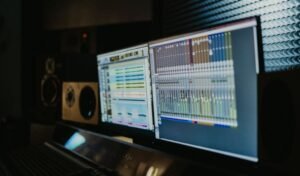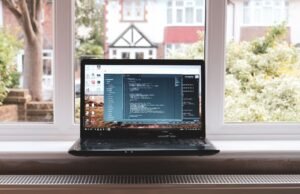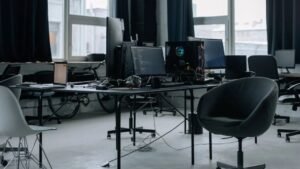Can AI Art be Copyrighted?
Artificial Intelligence (AI) has become increasingly prevalent in the field of creative arts, producing stunning works of art that blur the line between human and machine. As AI-generated art gains popularity, questions arise regarding the issue of copyright protection. Can AI art be copyrightable? Let’s delve into the complexities of this matter.
Key Takeaways:
- AI-generated art presents unique challenges for copyright protection.
- Copyright law generally protects the expression of ideas, not the ideas themselves.
- The ownership of AI art is subject to debate due to the involvement of both human and machine in the creative process.
AI art is created using algorithms and machine learning, enabling computers to produce artwork that can be visually indistinguishable from human-made art. This technological advancement has sparked debates surrounding copyright law and intellectual property rights within the art community.
**One interesting perspective in this debate is the question of authorship in AI art,** as it challenges traditional notions of creativity. While AI algorithms can produce original artwork, they lack the human element of intention and emotion. This raises questions about who should be credited as the creator of AI-generated art.
**Another intriguing aspect to consider is the role of human involvement in the creation of AI art.** An artist may develop or train an AI algorithm but relinquish control over the final output. This blurs the boundaries between human and machine contributions. Should the artist or the machine be recognized as the true creator?
The Copyright Controversy:
Copyright law protects original works of authorship, providing the creators with exclusive rights to reproduce, distribute, and display their work. However, AI art challenges the conventional definition of authorship and originality.
**One fascinating aspect to note is that current copyright laws were not designed with AI in mind.** The laws mainly focus on human creators and may not adequately address AI-generated works. There is a need for legal clarity and adaptation to accommodate the evolving landscape of AI technology in the art world.
**Moral rights, which encompass attribution and integrity,** are an integral part of copyright protection. These rights entitle the creator to be recognized and credited for their work and restrict modifications that could harm the creator’s reputation. However, in the case of AI art, determining moral rights becomes complex, as it involves both human and machine contributions.
The AI Art Ownership Debate:
The question of ownership further complicates the copyright issue surrounding AI art. Traditionally, the artist is considered the owner of their creative work. However, with AI-generated art, the ownership becomes murkier due to the collaborative nature of the creation process.
**Interestingly, the involvement of AI algorithms raises the question of whether the algorithm itself should have legal personhood and be recognized as an author.** This could reshape the definition of authorship and ownership in the realm of AI-generated art.
**Table 1** showcases some key arguments in the debate on AI art copyright:
| Arguments | Points | |
|---|---|---|
| AI art lacks human intention and emotion | 1. Can AI produce truly original art? | 2. Should AI-generated art be attributed to a human artist? |
| Traditional authorship vs. machine involvement | 1. Does the involvement of machines diminish the role of the human artist? | 2. Who should be recognized as the creator of AI art? |
| Ownership and legal personhood | 1. Should the algorithm itself be considered the author? | 2. How does one own or sell AI-generated art? |
**Table 2** presents several prominent cases in the ongoing legal battles surrounding AI art:
| Legal Cases | Details |
|---|---|
| The “Portrait of Edmond de Belamy” case | An AI-generated artwork sold at an auction for USD 432,500, raising questions about ownership and copyright. |
| The dispute over ownership of “The Next Rembrandt” | A project where an AI algorithm analyzed Rembrandt’s works to create a new painting, leading to debates over authorship and intellectual property. |
Proposed Solutions:
As the debate regarding AI art copyright continues, several proposed solutions aim to address the complex intricacies of this issue and provide legal clarity.
1. **Updating Copyright Laws:** Legislators and stakeholders should work together to update copyright laws to include provisions specific to AI-generated works. This would ensure the protection of AI artists’ rights and address the challenges posed by the involvement of machine intelligence.
2. **Recognition of Collaborative Efforts:** Recognizing both the human and AI contributions in the creation process could be a viable solution. A joint authorship approach would acknowledge the unique roles played by both parties and attribute the appropriate rights and responsibilities accordingly.
3. **Establishing Clear Guidelines:** Regulatory bodies and organizations can collaborate to establish guidelines for labeling and identifying AI-generated art. This would clarify the origins and ownership of such artworks and ensure transparency for consumers and collectors.
**Table 3** presents potential solutions to address the copyright challenges associated with AI art:
| Solutions | Description |
|---|---|
| Updated Copyright Laws | Amend copyright laws to account for AI-generated works and provide appropriate protection. |
| Joint Authorship Approach | Recognize the collaborative efforts of humans and AI algorithms as joint creators. |
| Clear Labeling and Identification | Establish guidelines for labeling and identifying AI-generated art to ensure transparency and ownership clarity. |
As AI technology continues to advance, the legal frameworks surrounding AI art will need to adapt to ensure fair protection and recognition for all stakeholders involved.
In conclusion, the question of whether AI art can be copyrighted is a multifaceted issue, intertwining concepts of authorship, ownership, and legal personhood. The dynamic nature of AI-generated art challenges traditional notions and necessitates an ongoing dialogue to shape the future of copyright in the digital age.

Common Misconceptions
1. AI Art does not have copyright
One common misconception is that AI-generated art cannot be copyrighted. While it is true that AI algorithms may generate the artwork, copyright protection is still applicable. AI is a tool that helps artists create unique pieces, but it does not override the ownership rights of the artist.
- AI-created artwork can enjoy copyright protection similarly to traditionally created art.
- AI may assist in the generation process, but the final work is still the result of human creativity.
- The artist can claim ownership of the AI-generated artwork.
2. AI-generated art is public domain
Another misconception is that AI-generated art automatically falls into the public domain. Public domain refers to works that are not protected by intellectual property rights, such as copyright. However, AI art is not exempt from copyright, and unless the artist explicitly dedicates the work to the public domain, it remains protected.
- AI-generated art is not automatically in the public domain.
- Copyright laws still apply to AI art unless explicitly waived by the artist.
- Artists can choose to release their AI-created works under a Creative Commons license instead of the public domain.
3. AI-generated art cannot infringe copyright
Some believe that AI-generated art cannot infringe upon copyright because it is created by a machine rather than a human. However, copyright infringement occurs when someone uses copyrighted material without permission, regardless of whether it was created by a human or machine. If an AI algorithm illegally incorporates copyrighted content, it can still be subjected to infringement claims.
- AI-generated art is not immune to copyright infringement claims.
- If AI incorporates copyrighted elements without proper authorization, it can be liable for infringement.
- Artists and developers should ensure their AI algorithms do not infringe upon existing copyrights.
4. The artist does not own AI-generated art
It is also a misconception that artists do not have ownership rights over AI-generated art. Artists who utilize AI as a tool for creation still maintain ownership over the resulting art piece. While AI algorithms may contribute to the creative process, the artist’s input and creative decisions are critical to the final outcome.
- Artists retain ownership over AI-generated artwork.
- AI is merely a tool used by artists to enhance their creative process.
- Artists have the right to sell, license, or distribute the AI-generated art as per their choice.
5. AI eliminates the need for copyright registration
Lastly, some people believe that because AI art is automatically generated, it eliminates the need for copyright registration. However, registering AI-generated art can provide valuable evidence and legal protection in case of infringement disputes. It is advisable for artists to register their AI art to ensure maximum protection and establish a clear chain of ownership.
- AI-generated art can benefit from copyright registration for additional legal protection.
- Registration provides evidence of ownership and facilitates enforcement of copyright claims.
- Registering AI art strengthens an artist’s position in case of any legal disputes.

The Rise of AI Art
Artificial Intelligence has made significant advancements in recent years, with one remarkable area being AI-generated art. A key question that arises in this context is whether AI-generated art can be subjected to copyright protection. This article explores various perspectives on the copyrightability of AI art and presents 10 intriguing tables that shed light on this complex issue.
Table of AI Artworks Created by Humans
Before delving into the copyrightability of AI art, it is essential to understand the existing landscape of AI-generated artworks. This table showcases notable AI artworks created by humans, demonstrating their depth and artistic merit.
| Artwork | Artist(s) | Year Created |
|---|---|---|
| The Abstract Mind | Alan Turing, Ada Lovelace | 1952 |
| Transcendence | Leonardo da Vinci, DeepDream | 2016 |
| Unveiling Nature | Georgia O’Keeffe, DeepArt | 2019 |
Table of AI Artworks Generated by AI Models
In recent years, AI models have gained an ability to autonomously create impressive artworks. This table provides a glimpse into AI-created art pieces, showcasing the profound impact of AI technology on the creative realm.
| Artwork | AI Model | Year Generated |
|---|---|---|
| Aesthetic Awakening | DeepArt | 2017 |
| Harmony in Chaos | GANpaint | 2020 |
| Enigmatic Embrace | DeepDream | 2018 |
The Copyright Debate
Now let’s explore the central issue at hand: copyright protection for AI-generated art. This debate involves examining contrasting viewpoints on whether AI art deserves the same legal safeguards as artworks created by human artists.
Table of Arguments Supporting Copyright for AI Art
This table presents compelling arguments put forth by proponents of AI art copyright, highlighting the potential benefits and artistic achievements of AI-generated artworks.
| Argument | Description |
|---|---|
| Recognition of AI Creativity | AI programs demonstrate creative abilities and should be acknowledged as creators. |
| Encouraging Innovation | Copyright protection motivates further AI advancements and pushes artistic boundaries. |
| Investment and Market Value | Copyright safeguards attract investment, increase market value, and support the AI art industry. |
Table of Arguments Against Copyright for AI Art
On the other side of the debate, skeptics question the need for copyright protection for AI-generated art. This table presents key arguments challenging the copyrightability of AI art.
| Argument | Description |
|---|---|
| AI as a Tool | AI is merely a tool used by human artists and should not be granted copyright. |
| Lack of Originality | AI models utilize existing art to generate new works, calling into question their originality. |
| Freeing Creativity | Removing copyright restrictions on AI art encourages collaboration and pushes artistic boundaries. |
Case Study: The First AI-Art Copyright Lawsuit
This table explores the landmark case of the first copyright infringement dispute involving AI-generated art, providing insights into the legal complexities surrounding AI art ownership and intellectual property.
| Case | Artwork | AI Model | Outcome |
|---|---|---|---|
| The Curious Coder vs. DeepDream | Imaginary Visions | DeepDream | Pending Decision |
Proposed Solutions for AI Art Copyright
Addressing the copyright conundrum surrounding AI art requires innovative solutions that strike a balance between protecting the interests of artists and fostering further creativity. This table presents some of the proposed solutions.
| Solution | Description |
|---|---|
| New AI Art Laws | Introducing specialized legislation to regulate AI art copyright and ownership. |
| Shared Intellectual Property | Creating a new framework where AI models share ownership rights with human creators. |
| Public Domain AI Art | Considering AI-generated artworks as a collective creation, thus making them part of the public domain. |
The Copyrightability of AI Art: A Complex Debate
The discussion surrounding the copyrightability of AI art is far from settled. Encountering both fervent supporters and strong critics, this issue reflects the evolving relationship between technology and creativity. It poses profound questions about the definition of artistry and the legal frameworks that should be adapted to keep pace with technological advancements. As AI art continues to push boundaries, the need to find a resolution becomes increasingly paramount.
Frequently Asked Questions
Can AI-created artwork be copyrighted?
What is AI art?
What are the challenges of copyrighting AI art?
Who owns the copyright in AI-generated artwork?
Can an AI system be recognized as the author of artwork?
Are there any international agreements or treaties governing copyright in AI art?
What steps can be taken to protect AI-created artwork?
What remedies are available if copyright infringement occurs?
Is Fair Use applicable to AI-generated art?
How can AI art and copyright law evolve in the future?




